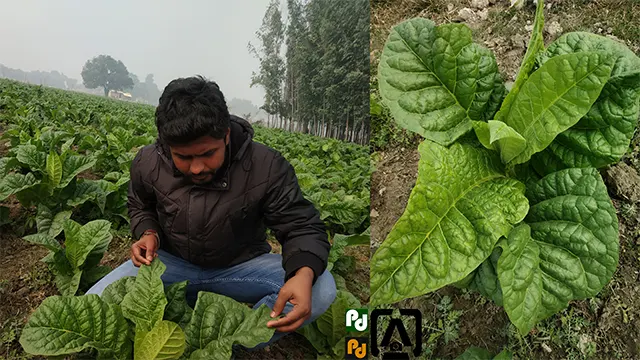Tobacco mosaic disease
Host: Tobacco, tomato, pepper and other solanaceous plants
Pathogen: Tobacco mosaic virus (TMV)
Pathogen: Tobacco mosaic virus (TMV)
History
The disease was first identified by Adolf Mayer in 1886 as a transferable disease in plants probably caused by bacteria. Dmitri Ivanovsky in 1892 found that the infected sap of plant is still infectious even after filtering through Chamberland filters. This gave evidence of non-bacterial infectious agent causing mosaic disease in tobacco. In 1903 Ivanovsky in his paper published about the connection between intracellular inclusions and the causative agent of the disease. He argued that tobacco mosaic disease was caused by these inclusions, which are too small to be observed under light microscope and are able to pass the Chamberland filter, which a bacteria do not. Martinus Beijerinck of Netherland in 1898 showed that the infectious crystals from infected filtrate were able to multiply and reproduce in the host cell. He coined the term 'virus' to separate these particles from bacteria. Wendell Meredith Stanley in 1935 for the first time crystallized the TMV. It was very first virus to be crystallized. Gustav Kausche, Edgar Pfankuch and Helmut Ruska produced first electron microscopic image of TMV in 1939.
 |
| Healthy leaves of tobacco in field |
Symptoms
Symptoms of TMV depend upon the strain of virus, genetic makeup of host plant, age of infected plant and the environmental conditions. Early symptoms appear in the form of light green coloration between the young leaves, which later turn into mosaic of light and dark green areas. Infected leaves are mottled. TMV infection does not kill the plants, but the infected plants remain stunted.
Pathogen
TMV is a positive-sense single-stranded RNA virus. It belongs to genus Virgaviridae of virus family: Tobamovirus. TMV is a rod-shaped virus measuring 300 nm (length) × 15 nm (diameter). Its coat protein (capsid) is made up of 2,130 units envelop the RNA molecule of 6,400 nucleotides. There are 16.3 coat protein units per helix. Single monomere of capsid (capsomere) consists of 158 amino acid residues. TMV is thermostable and can withstand heat at 50 °C for up to 30 minutes. Purified TMV remains infectious even after 50 years of storage in the laboratory at 4°C.
Transmission
TMV can survive in the soils, leaves and stalks. It can survive in ifected tobacco product for many years. TMV is reported in cigarettes and saliva of smokers (Balique et al., 2012). Transmission of TMV occurs by direct contact of plants to plants. There is no specific vector for the transmission, however aphids, leafhoppers and insect can transmit the disease. TMV spreads through the contaminated tools and workers hands.
After infection TMV replicates and spreads into the host cells through plasmodesmata. A 30 kDa movement protein called P30 produced by the TMV helps in smooth movement of virus through the plasmodesmata.
After infection TMV replicates and spreads into the host cells through plasmodesmata. A 30 kDa movement protein called P30 produced by the TMV helps in smooth movement of virus through the plasmodesmata.
Control measures
- In order to inactivate the virus, tools used in the field should be sanitized with soap or 10 % solution of household bleach.
- Infected plants should be removed and burnt.
- Hands should be washed after planting every single plant.
- Crop rotation of two years with non-solanaceous plants should be practiced.
- TMV resistant cultivars should be raised.
- Inoculating the young plants with a mild strain of the virus can protect them from subsequent infection by more severe strains, a strategy called "cross protection" (similar to vaccination).
References
- Balique, F., Colson, P. and Raoult, D., 2012. Tobacco mosaic virus in cigarettes and saliva of smokers. Journal of clinical virology, 55(4), pp.374-376.(https://doi.org/10.1016/j.jcv.2012.08.012)
First published on 15-01-2021
Last updated on 23-10-2021
Last updated on 23-10-2021




